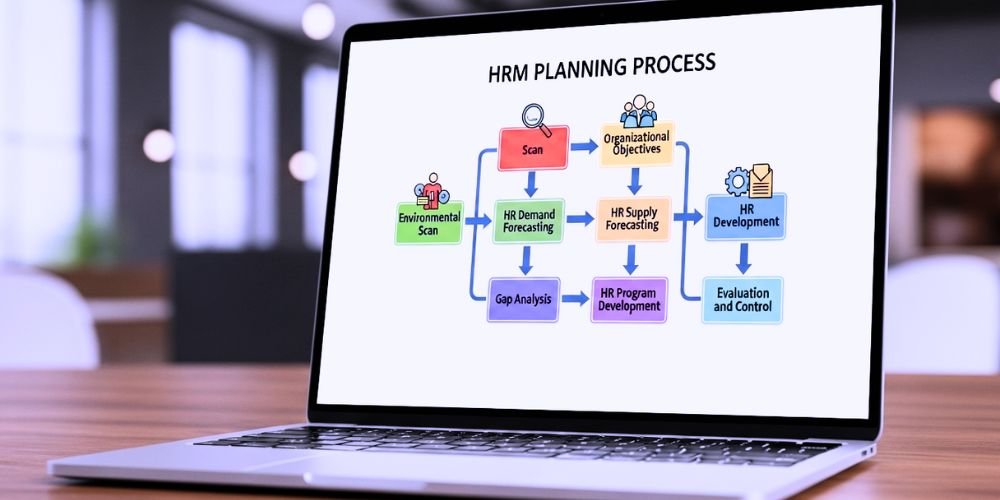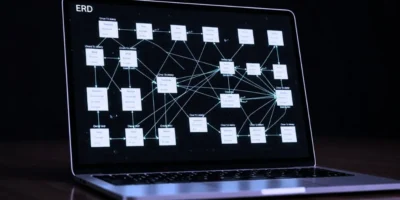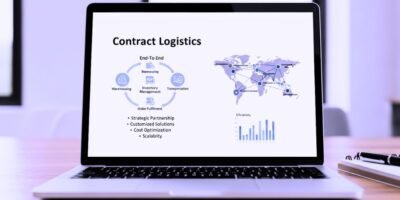Strategic Human Resource Management (HRM) planning is a vital process that aligns an organization’s HR practices with its overall strategic goals. This article explores the HRM planning process, its key components, and how it helps organizations shape the future of their human resources.
Understanding the HRM Planning Process
The HRM planning process systematically identifies, analyzes, and addresses an organization’s current and future HR needs. It encompasses several key components that guide HR professionals in developing strategies and initiatives to support the organization’s strategic direction. Organizations can build a high-performing workforce that drives sustainable success by forecasting future workforce needs, developing strategies to attract and retain talent, and implementing effective HR programs.
Key Components of the HRM Planning Process
One of the most important aspects of effective HRM planning understands the key components that drive the process.
Environmental Analysis
The first step in the HRM planning process is conducting an environmental analysis. It involves assessing external factors impacting the organization’s HR practices, such as economic conditions, labor market trends, technological advancements, and legal and regulatory changes. Understanding the exterior landscape helps HR professionals anticipate challenges and identify opportunities for strategic HR interventions.
Internal Analysis
After the external analysis, HR professionals conduct an internal investigation of the organization. It involves evaluating the current workforce, assessing skills and competencies, identifying gaps, and analyzing employee performance and engagement. The internal analysis provides insights into the organization’s strengths, weaknesses, and areas for improvement regarding human resources.
Forecasting Workforce Needs
Forecasting future workforce needs is a critical component of the HRM planning process. HR professionals project the organization’s future talent requirements based on anticipated changes in business strategies, growth plans, and market demands. They consider retirement rates, attrition, expansion plans, and technological advancements to estimate the needed quantity and quality of talent.
Talent Acquisition and Retention Strategies
Based on workforce forecasting, HR professionals develop talent acquisition and retention strategies. It involves identifying the skills and competencies required, establishing recruitment plans, and implementing effective selection and onboarding processes. Additionally, HR develops retention strategies, such as career development programs, succession planning, and employee engagement initiatives, to attract and retain top talent.
Training and Development
The HRM planning process includes identifying training and development needs to enhance the skills and capabilities of the workforce. HR professionals assess current skill gaps, determine training priorities, and design learning programs to bridge those gaps. Training and development initiatives can encompass workshops, seminars, e-learning platforms, mentoring, and coaching programs.
Performance Management
Performance management is an integral part of the HRM planning process. HR professionals develop performance management systems that align individual and team goals with organizational objectives. They establish performance standards, design performance appraisal processes, and implement feedback mechanisms to foster continuous improvement and enhance employee performance.
HR Metrics and Evaluation
HR professionals establish HR metrics and evaluation mechanisms to gauge the effectiveness of HRM planning initiatives. They define key performance indicators (KPIs) to measure the impact of HR programs on organizational performance. These metrics can include employee turnover rates, productivity levels, employee satisfaction, and the cost-effectiveness of HR initiatives. Regular evaluation allows HR to make data-driven decisions and refine strategies for optimal results.
Benefits of the HRM Planning Process
An effective HRM planning process can lead to several benefits for the organization and its employees.
Alignment with Organizational Strategy
The HRM planning process ensures that HR practices align with the organization’s strategic goals. It enables HR professionals to proactively anticipate talent needs, develop recruitment and retention strategies, and design HR initiatives contributing to the organization’s success.
Effective Talent Management
By forecasting workforce needs, HRM planning enables organizations to attract, develop, and retain the right talent. It ensures the organization has the necessary skills and competencies to meet current and future business demands. Effective talent management improves productivity, drives innovation, and enhances overall performance.
Adaptability to Changing Business Environment
The HRM planning process enables organizations to adapt to changing market conditions. It equips HR professionals with the tools and insights to anticipate and address challenges like technological advancements, skill shortages, and evolving customer expectations. By aligning HR practices with emerging trends, organizations can stay competitive and future-proof their workforce.
Efficient Resource Allocation
Strategic HRM planning optimizes the allocation of HR resources. By identifying talent needs, HR professionals can allocate resources effectively, ensuring that the right people are in the right roles at the right time. It improves operational efficiency, reduces costs associated with turnover, and enhances organizational agility.
Enhanced Employee Engagement and Satisfaction
The HRM planning process focuses on employee engagement and satisfaction. Organizations create an environment that fosters employee growth and happiness by identifying training needs, providing career development opportunities, and implementing performance management systems. Engaged employees are more likely to be motivated, productive, and committed to the organization’s success.
Conclusion
The HRM planning process is a strategic endeavor that enables organizations to shape the future of their human resources. Organizations can build a high-performing workforce aligned with their strategic objectives by conducting environmental and internal analyses, forecasting workforce needs, developing talent acquisition and retention strategies, and implementing training and performance management initiatives.
The benefits of the HRM planning process include alignment with organizational strategy, effective talent management, adaptability to change, efficient resource allocation, and enhanced employee engagement. By embracing the HRM planning process, organizations can proactively address HR challenges and position themselves for long-term success in a dynamic business landscape.













